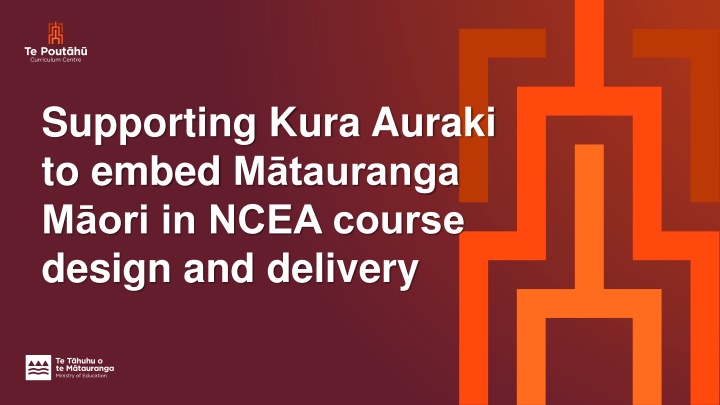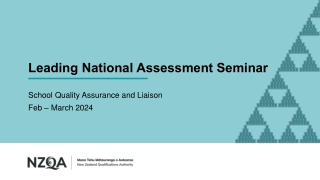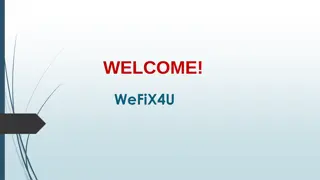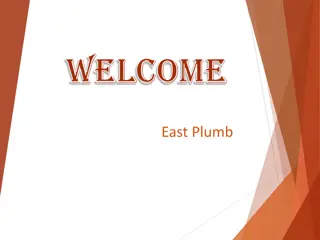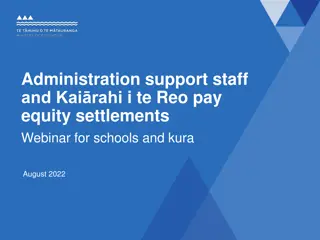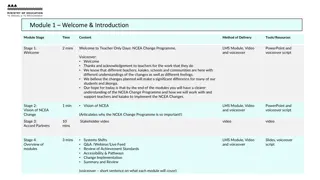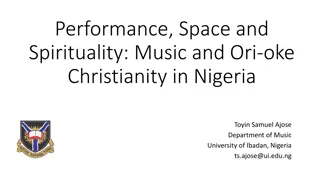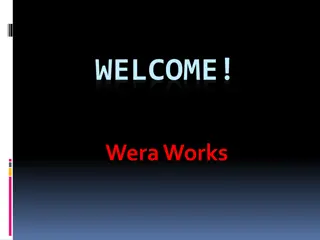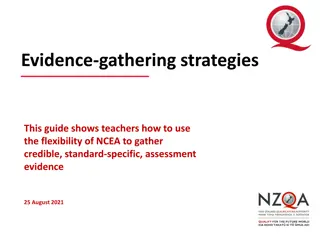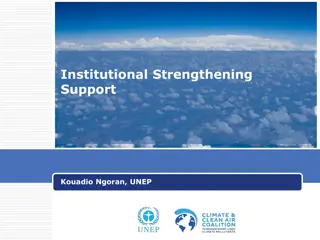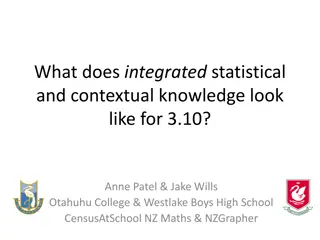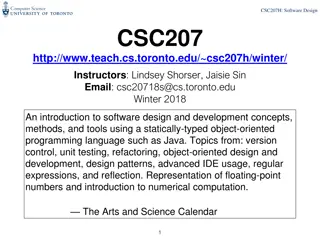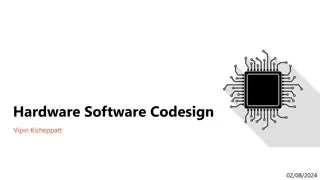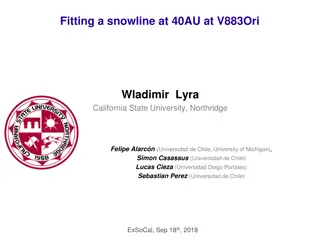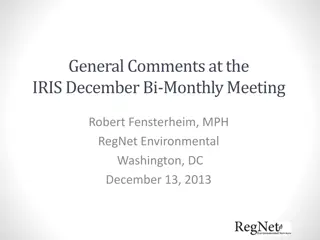Supporting Kura Auraki to Embed Mātauranga Māori in NCEA Course Design
These activities focus on integrating Mātauranga Māori into NCEA course design and delivery. The resource provides guidance on critical thinking, drawing out cultural knowledge, and upholding authenticity in educational practices.
Download Presentation

Please find below an Image/Link to download the presentation.
The content on the website is provided AS IS for your information and personal use only. It may not be sold, licensed, or shared on other websites without obtaining consent from the author.If you encounter any issues during the download, it is possible that the publisher has removed the file from their server.
You are allowed to download the files provided on this website for personal or commercial use, subject to the condition that they are used lawfully. All files are the property of their respective owners.
The content on the website is provided AS IS for your information and personal use only. It may not be sold, licensed, or shared on other websites without obtaining consent from the author.
E N D
Presentation Transcript
Supporting Kura Auraki to embed M tauranga M ori in NCEA course design and delivery
These activities will help you to: 1 2 3 Think critically about how Matauranga M ori is included in NCEA course design and delivery. Explore ways to draw out the Matauranga inherent in the materials and existing resources to support learning outcomes. Establish appropriate tikanga to ensure that authenticity is upheld, and integrity is maintained. temahau.govt.nz 2
Notes for curriculum leaders who are using this resource 1. There are 6 activities outlined in this slide deck. 2. The activities can be used as part of your teacher-only day and as an ongoing resource to help your school or department. 3. This resource is designed to be used alongside the existing resources for Mana ritem Te M taurangaM ori available on the NCEA Website. 4. These activities build on one another and should be used in the correct sequence. 5. Each activity has been tagged with a time allowance to assist planning. These are very approximate and can be adjusted to your context and time frame. 3 temahau.govt.nz
MtaurangaMori in NCEA M tauranga M ori is foundational to New Zealand s national identity, history and culture. Meaningful access to learning grounded in M taurangaM ori is therefore significant for all New Zealanders, both M ori and non-M ori alike. All teachers and school leaders have a fundamental part to play to ensure NCEA is more reflective of Aotearoa New Zealand as it is today. In doing so they begin to fulfil their role as a Treaty partner in a meaningful and active way. Continuing to embed M tauranga M ori in NCEA will improve outcomes for akonga M ori by improving responsiveness of teaching and assessment practices to M ori lived experiences, culture, language and aspirations. Drawing on local stories, working with and gathering knowledge from local Iwi and by drawing on key M ori concepts and values such as kaitiakitanga, wh naungatanga and Kotahitanga will ensure a culturally appropriate and enriched curriculum for all learners. temahau.govt.nz 4
MtaurangaMori in NCEA The NCEA materials has been designed in a way that allows teachers to include M tauranga M ori in their course design and planning considering various levels of ability and understanding. Teachers do not have to be experts, but they do need to develop an understanding of some basic concepts and tikanga that will enable them to engage more readily with the M tauranga M ori inherent in the NCEA materials. Understanding and applying concepts such as whakapapa and tikanga to the learning design process supports kaiako and leaders to maintain the authenticity and integrity of the M tauranga including how it should be used and engaged with by akonga. Everyone is at different stages of their M tauranga M ori journey. This resource aims to support teachers and leaders to grow understanding and capability no matter what stage they are at. temahau.govt.nz 5
Engaging Appropriately with MtaurangaMori The Matauranga M ori Positioning Statement (MMS) developed by Te Whakaruruhau serves as a guide on how we might engage appropriately with Matauranga M ori. Knowledge is created by collective minds which give it life. We need to ensure M tauranga M ori has a whakapapa of an explanation of where the knowledge has come from and how it connects to w nanga. Whakapapa is designed to ensure the learning opportunities. the mauri of all things is present and active. This requires tikanga to ensure that that Knowledge should be treasured. Protecting knowledge, as a taonga (treasure), ensures it is used appropriately, and validates that the elements incorporated mauri is treated appropriately, protected, in it make it authentic in its use and is authentic Knowledge should be respected. Using knowledge in a respectful manner The way this is done, is through ensures our interactions with learning are authentic, wholesome, and the kawa whakahaere . Kawa sets the meaningful. When knowledge is understood, it is important that it is used parameters on how M tauranga will be appropriately and respectfully. engaged with and guides our interactions with the kaupapa. Whakahaere creates space for Knowledge evolves and adapts. Building new knowledge is constant, acknowledging that this occurs through old knowledge evolving. In some new M tauranga to evolve, and existing M tauranga to adapt. instances, the knowledge doesn t change, it is the situation(s) that adapt and temahau.govt.nz 6 therefore knowledge never stands still.
Activity 1 Ko tou rourou, ko taku rourou ka ora ai te iwi With your basket and my basket the people are sustained Use this whakatauki to develop a bus stop activity that unpacks each aspect of the MMS. What questions or ideas does each aspect prompt about engaging with M tauranga M ori? (45mins) temahau.govt.nz 7
Deepening our Understanding This activity draws on selected understandings about tikanga, taonga and whakapapa from Insights into kaupapa M ori | NCEA (education.govt.nz) to guide thinking about planning and design processes. Note that there are other concepts included in this resource that can also be referred to. Exploring how the concept of tikanga might inform how M taurangaM ori is included in course design Discuss why it is important to consider tikanga in the inclusion of M tauranga M ori in course design and delivery. Identify what tikanga have been applied to your current context and what other tikanga might need to be considered in the future. (2.1) View Insights into Kaupapa M ori: Tikanga Viewing M taurangaM ori as a taonga and exploring how this influences our actions as teachers and leaders Discuss the concept of taonga as explained in the video and how viewing M tauranga M ori as a Taonga might impact on our actions as teachers in the classroom and/or leaders in the wider school environment. (2.2) View insights into Kaupapa M ori: Taonga Understanding how the concept of whakapapa can be applied to how we engage with and use M tauranga within the NCEA materials Discuss the elements of whakapapa as described in the video and identify examples of these that can be found in your own school context. Identify whakatauki associated with your subject area and how they relate to or link to other kupu M ori in the Learning Matrix or EN2s. (2.3) View insights into Kaupapa M ori: Whakapapa Activity 2: After each video stop and discuss the follow-up questions as a whole group. (45mins) temahau.govt.nz 8
Engaging Appropriately with MtaurangaMori Reflecting on Programme Design Matauranga M ori Positioning Statement Think about . Whakapapais designed to ensure the mauri of all things is present, active, and understood. Where does the Matauranga come from and how does it connect students to mana whenua, and/or the local environment? What supporting knowledge do students need? What is an appropriate Te Ao M ori context that can house the big ideas/significant learning and selected standards (P rakau, historical events, significant geographical features, whakatauki etc) What deeper understandings of kupu and m tauranga do students need to be successful? What are some localised whakatauki/pepeha that might further support that understanding? Knowledge is created by collective minds which give it life. We need to ensure an explanation of where the knowledge has come from and where it is now is included in learning opportunities. Tikanga ensures that mauri is treated appropriately, protected, and is authentic. What tikanga should be observed to ensure the M tauranga is authentic and is being treated correctly? What conversations have been carried out about the inclusion of M taurangaM ori and with whom? How does the inclusion of M taurangaM ori serve mana whenua, M ori students and their communities? Knowledge should be treasured. Protecting knowledge, as a taonga, ensures it is used appropriately, and validates that the elements incorporated in it make it authentic in its use. How can its authenticity be verified? Activity 3: Using this template as a guide, discuss and note down ideas specific to your department or subject area (45 mins) temahau.govt.nz 9
Engaging Appropriately with MtaurangaMori Matauranga M ori Positioning Statement Reflecting on Programme Design Think about . What needs to be carried out and in what order? How might tikanga support students to understand, know and do? Kawa sets the parameters on how M tauranga will be engaged with and guides our interactions with the kaupapa. How does the M tauranga connect to what is being assessed? Does it need to? Knowledge should be respected. Using knowledge in a respectful manner ensures our interactions with learning are authentic, wholesome, and meaningful. When knowledge is understood, it is important that it is used appropriately and respectfully What existing knowledge has evolved or been adapted in this space? How has the teaching and/or the programme adapted or changed to ensure the integrity of the M tauranga? Whakahaere creates space for new m tauranga to evolve, and existing m tauranga to adapt. Knowledge evolves and adapts. Building new knowledge is constant, acknowledging that this occurs through old knowledge evolving. In some instances, the knowledge doesn t change, it is the situation(s) that adapt and therefore knowledge never stands still. What new knowledge has eventuated? How has the inclusion of M tauranga impacted on learning outcomes for students? How has it informed the assessment activity? (Continued from previous slide) temahau.govt.nz 10
Exploring the relationships between whakatauki, kupu and the learning To gain a deeper understanding of M tauranga M ori, concepts such as whanaungatanga and manaakitanga should ideally be referred to in relation to each other and not stand alone. Manaakitanga Subject (or localised) whakatauki provide a central point (or pou) that kaiako can continually reference upon and draw out deeper understandings of the related kupu with students. Kaua e rangiruatia te hapai o te hoe e kore tatou waka e u ki uta* Whakapapa Kaitiakitanga Activity 4: Using the diagram as an example discuss how the learning area whakatauki (from Technology) and kupu relate and connect to each other. How might this be used to draw out deeper understandings for students of the learning? Whanaungatanga Note: This activity can be adapted to your learning area. *Don t lift the paddle out of unison our waka will never reach the shore temahau.govt.nz 11
Weaving MtaurangaMori into Curriculum Design Activity 5: Share an aspect of M taurangaM ori and how you ve integrated it into curriculum planning 1 2 3 Mapping Whakatauaki Exploration Connecting Whakatauaki and Learning Outcomes M taurangaM ori origins 30 mins temahau.govt.nz 12 3/2/2025
Thinking Critically about Including Mtauranga Mori in Course Design Activity 6: Explore the relationships between the M taurangaM ori concepts in the Subject Learning Outcomes. How can you draw and build on these relationships throughout the sequences of learning? 1. Consider- Identify a Te Ao M ori context relevant to your local area that could house significant learning and big ideas. Discuss associated subject whakatauki and how they relate to kupu e.g. manaakitanga and kaitiakitanga. (If necessary, pause to view Insights into kaupapa M ori | NCEA (education.govt.nz) to clarify understandings. What other whakatauki and kupu might be relevant to your context? Discuss and specify how these understanding connect to and support subject learning outcomes. How might these understanding shape the development of learning and assessment activities and the ongoing feedback/feedforwards that you might give to students? 2. 3. 4. (45 Mins) temahau.govt.nz 13
Developing your individual Matauranga Mori Action plan Deepen Understanding Localized Te Ao M ori Context Weaving Whakatauaki and Kupu Monitoring Progress Seeking Support Concepts to explore: Identify relevant whakatauaki (proverbs) or kupu (words) related to your subject area Commit to deepening your understanding of these concepts How? Readings, engage with local experts, workshops, participate in cultural experiences Integration Points: Consider where in your current teaching and learning programme you can include a localized Te Ao M ori context Look for opportunities to infuse M tauranga M ori seamlessly Examples: Integrate local legends, geographical features, or cultural practices into specific units of lessons Coherent Connection: How will you weave and connect whakatauaki and kupu to the learning in a coherent manner? Ensure alignment with learning outcomes. Strategies: Embed relevant whakatauaki within lesson introductions, discussions, or assessments Use kupu to reinforce key concepts Assessment and Reflection: Regularly assess how well you re integrating M tauranga M ori Reflect on student engagement and understanding Tools: Use student feedback to gauge progress Information and Guidance: Identify areas where you need further information or support Seek guidance from colleagues, kaumatua, wh nau, community, or online resources Resources: Visit local marae, connect with iwi, explore websites or attend PLD session temahau.govt.nz 14
Reflecting as a Department on the Inclusion of Mtauranga M ori To what extent has M taurangaM ori been embedded in our learning area or department? How do we know? How does tikanga inform the way M taurangaM ori has been included in our planning? What other tikanga do we need to consider implementing to strengthen our department? Who do we need to involve in strengthening this process? To what extent has M taurangaM ori been included in teacher planning? What strategies do we need to strengthen teacher capability and understanding? temahau.govt.nz 15
